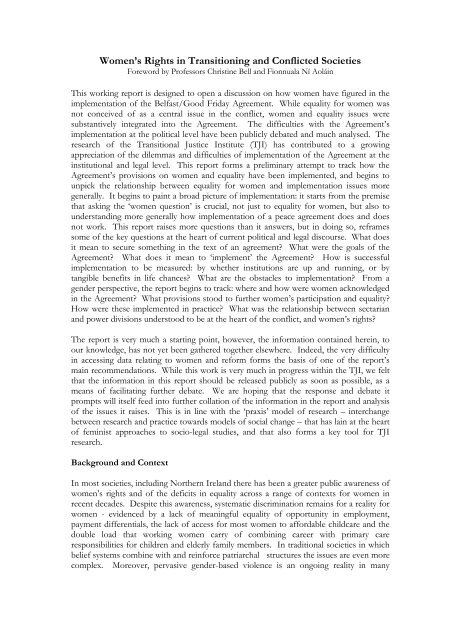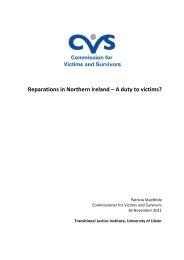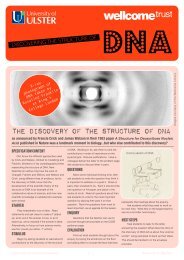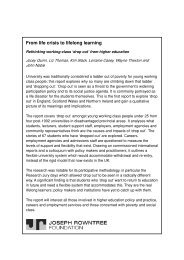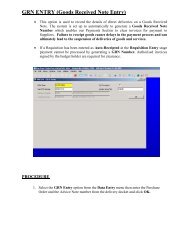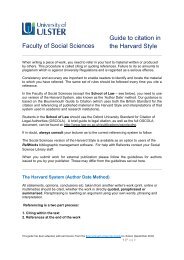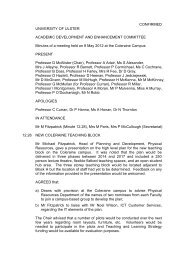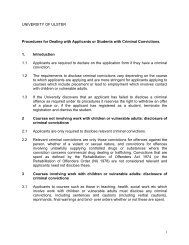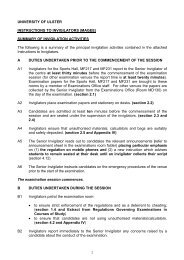Agreement Reached in the Multi-Party Negotiations - Transitional ...
Agreement Reached in the Multi-Party Negotiations - Transitional ...
Agreement Reached in the Multi-Party Negotiations - Transitional ...
You also want an ePaper? Increase the reach of your titles
YUMPU automatically turns print PDFs into web optimized ePapers that Google loves.
Women’s Rights <strong>in</strong> Transition<strong>in</strong>g and Conflicted Societies<br />
Foreword by Professors Christ<strong>in</strong>e Bell and Fionnuala Ní Aolá<strong>in</strong><br />
This work<strong>in</strong>g report is designed to open a discussion on how women have figured <strong>in</strong> <strong>the</strong><br />
implementation of <strong>the</strong> Belfast/Good Friday <strong>Agreement</strong>. While equality for women was<br />
not conceived of as a central issue <strong>in</strong> <strong>the</strong> conflict, women and equality issues were<br />
substantively <strong>in</strong>tegrated <strong>in</strong>to <strong>the</strong> <strong>Agreement</strong>. The difficulties with <strong>the</strong> <strong>Agreement</strong>’s<br />
implementation at <strong>the</strong> political level have been publicly debated and much analysed. The<br />
research of <strong>the</strong> <strong>Transitional</strong> Justice Institute (TJI) has contributed to a grow<strong>in</strong>g<br />
appreciation of <strong>the</strong> dilemmas and difficulties of implementation of <strong>the</strong> <strong>Agreement</strong> at <strong>the</strong><br />
<strong>in</strong>stitutional and legal level. This report forms a prelim<strong>in</strong>ary attempt to track how <strong>the</strong><br />
<strong>Agreement</strong>’s provisions on women and equality have been implemented, and beg<strong>in</strong>s to<br />
unpick <strong>the</strong> relationship between equality for women and implementation issues more<br />
generally. It beg<strong>in</strong>s to pa<strong>in</strong>t a broad picture of implementation: it starts from <strong>the</strong> premise<br />
that ask<strong>in</strong>g <strong>the</strong> ‘women question’ is crucial, not just to equality for women, but also to<br />
understand<strong>in</strong>g more generally how implementation of a peace agreement does and does<br />
not work. This report raises more questions than it answers, but <strong>in</strong> do<strong>in</strong>g so, reframes<br />
some of <strong>the</strong> key questions at <strong>the</strong> heart of current political and legal discourse. What does<br />
it mean to secure someth<strong>in</strong>g <strong>in</strong> <strong>the</strong> text of an agreement? What were <strong>the</strong> goals of <strong>the</strong><br />
<strong>Agreement</strong>? What does it mean to ‘implement’ <strong>the</strong> <strong>Agreement</strong>? How is successful<br />
implementation to be measured: by whe<strong>the</strong>r <strong>in</strong>stitutions are up and runn<strong>in</strong>g, or by<br />
tangible benefits <strong>in</strong> life chances? What are <strong>the</strong> obstacles to implementation? From a<br />
gender perspective, <strong>the</strong> report beg<strong>in</strong>s to track: where and how were women acknowledged<br />
<strong>in</strong> <strong>the</strong> <strong>Agreement</strong>? What provisions stood to fur<strong>the</strong>r women’s participation and equality?<br />
How were <strong>the</strong>se implemented <strong>in</strong> practice? What was <strong>the</strong> relationship between sectarian<br />
and power divisions understood to be at <strong>the</strong> heart of <strong>the</strong> conflict, and women’s rights?<br />
The report is very much a start<strong>in</strong>g po<strong>in</strong>t, however, <strong>the</strong> <strong>in</strong>formation conta<strong>in</strong>ed here<strong>in</strong>, to<br />
our knowledge, has not yet been ga<strong>the</strong>red toge<strong>the</strong>r elsewhere. Indeed, <strong>the</strong> very difficulty<br />
<strong>in</strong> access<strong>in</strong>g data relat<strong>in</strong>g to women and reform forms <strong>the</strong> basis of one of <strong>the</strong> report’s<br />
ma<strong>in</strong> recommendations. While this work is very much <strong>in</strong> progress with<strong>in</strong> <strong>the</strong> TJI, we felt<br />
that <strong>the</strong> <strong>in</strong>formation <strong>in</strong> this report should be released publicly as soon as possible, as a<br />
means of facilitat<strong>in</strong>g fur<strong>the</strong>r debate. We are hop<strong>in</strong>g that <strong>the</strong> response and debate it<br />
prompts will itself feed <strong>in</strong>to fur<strong>the</strong>r collation of <strong>the</strong> <strong>in</strong>formation <strong>in</strong> <strong>the</strong> report and analysis<br />
of <strong>the</strong> issues it raises. This is <strong>in</strong> l<strong>in</strong>e with <strong>the</strong> ‘praxis’ model of research – <strong>in</strong>terchange<br />
between research and practice towards models of social change – that has la<strong>in</strong> at <strong>the</strong> heart<br />
of fem<strong>in</strong>ist approaches to socio-legal studies, and that also forms a key tool for TJI<br />
research.<br />
Background and Context<br />
In most societies, <strong>in</strong>clud<strong>in</strong>g Nor<strong>the</strong>rn Ireland <strong>the</strong>re has been a greater public awareness of<br />
women’s rights and of <strong>the</strong> deficits <strong>in</strong> equality across a range of contexts for women <strong>in</strong><br />
recent decades. Despite this awareness, systematic discrim<strong>in</strong>ation rema<strong>in</strong>s for a reality for<br />
women - evidenced by a lack of mean<strong>in</strong>gful equality of opportunity <strong>in</strong> employment,<br />
payment differentials, <strong>the</strong> lack of access for most women to affordable childcare and <strong>the</strong><br />
double load that work<strong>in</strong>g women carry of comb<strong>in</strong><strong>in</strong>g career with primary care<br />
responsibilities for children and elderly family members. In traditional societies <strong>in</strong> which<br />
belief systems comb<strong>in</strong>e with and re<strong>in</strong>force patriarchal structures <strong>the</strong> issues are even more<br />
complex. Moreover, pervasive gender-based violence is an ongo<strong>in</strong>g reality <strong>in</strong> many


